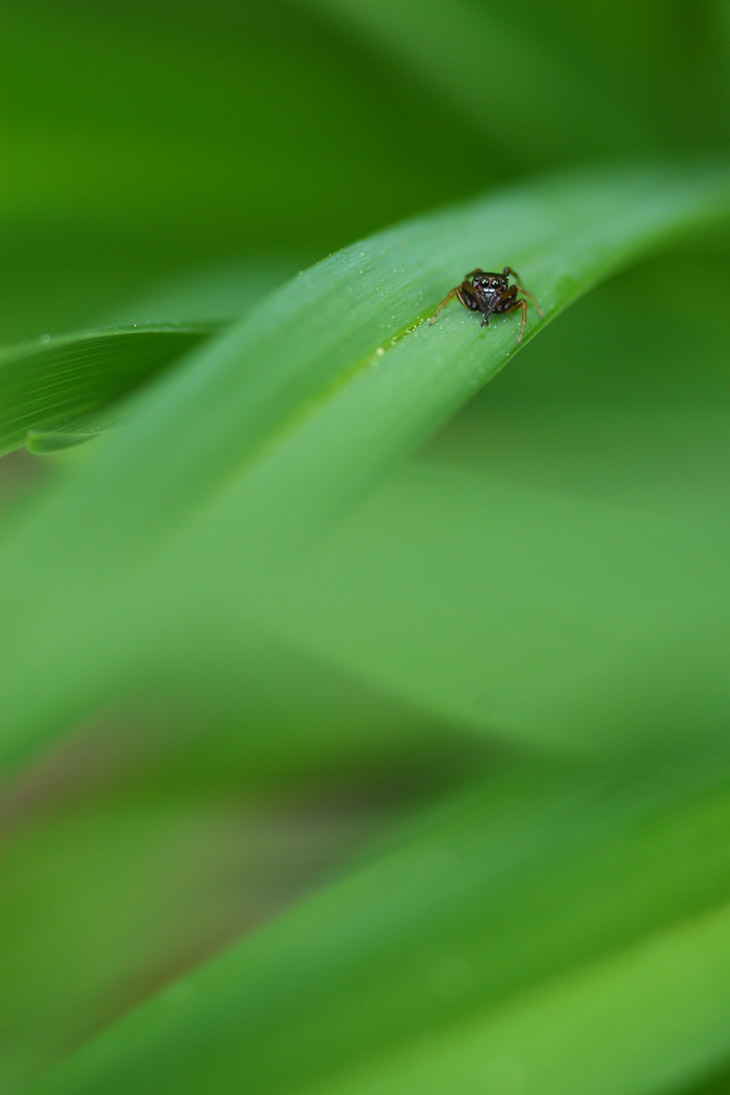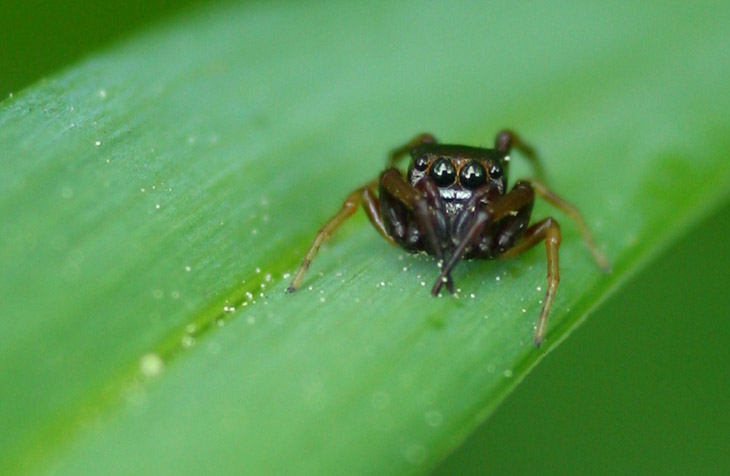Just a few pics from yesterday morning not long after sunrise, poking around in the yard looking for subjects. While I had initially modified a 80mm macro lens from my Mamiya medium format camera to work on Canon bodies when my Sigma lens failed, I have maintained the use of it because it’s one damn sharp lens, despite the fact that both focus and aperture must be manually controlled. I cut my teeth on fully manual cameras, and have even worked with external exposure meters and sometimes no meter at all, so the little bit of extra effort barely even registers.
Here, we have a tiny jumping spider perched on the newly-emerging day lilies, so small that I had to lean in close to even determine that it was a spider and not just a bit of chaff. I wasn’t bothering with the flash rig at the time (yeah, I know, I just got done boasting about making extra effort without batting an eye, and now I can’t be assed to affix the flash-and-softbox,) so in the weak dawn light I was shooting wide open at f4, demonstrating just how short the depth of field can be in macro work.

That’s full frame, and some of that gauzy effect in the middle comes from leaves very close to the lens and extremely far out of focus. But let’s instead take a close look at the spider itself, still sluggish from the overnight chill but well aware of my presence.

This is a full-resolution inset of the same frame, so it shows the level of detail captured. I didn’t get a measurement at the time, but checking just now, the leaf is about 10mm wide, making the spider somewhat less than 2mm across the cephalothorax (“head”) – the pale specks you see scattered on the leaf and spider are pine pollen. Overall, it’s a little oasis of sharpness in an otherwise misty frame – I’m trying to decide if the full-frame image would make a good art print. I mean, I like it, but we’ve established that I’m pretty weird and thus perhaps not representative of the art market as a whole.
The next one, however, I know not to bother with. It’s a bit too scattered and confusing, a clash of contrast and elements that don’t contribute to the effect in a positive manner; some frames just don’t work. But it’ll serve to illustrate the lens performance anyway. Here’s the full frame:

That’s a crane fly, infraorder Tipulomorpha, perched on one of the rosemary plants; not even a fraction as surreal as the day lily leaves. But we’ll ignore my failings for a moment and go for a full resolution inset again.

Yep, a couple more pollen grains in there, and if you look really close, you might make out the faint feathery tendrils that branch out from the sides of the antennae. If I remember right, the light allowed me to stop down to f8 for this one, but the depth is still pretty short, as evidenced by the legs and rosemary leaves.
Now, a quick note. Autofocus, had it been available, would have been of little use here. Even if it was accurate enough to snag the precise portion of an arthropod that I wanted sharp, there’s the simple factor that I was shooting handheld in natural light, with a very short range of sharp focus available; to put it simply, infinitesimal body movements (my own) constantly shift such subjects into and out of critical sharpness. Add in that the view in the viewfinder is much smaller than seen here on your monitor; I can’t give a good impression since I don’t know how big your monitor is nor what resolution it produces, but I would say my viewfinder image is probably much less than half what you’re seeing here. This isn’t bragging – I have plenty of frames which missed, which is why I take a lot of them when doing macro work, trying to time my own movements carefully, getting as stable as possible, and usually while holding my breath. Seriously, my arms braced against my ribcage add in another factor of movement that I’d rather do without; on occasion when pursuing a difficult subject, I have to stop and take a few deep breaths to replenish my system. Moreover, the shooting angles and perspectives that I try for often require being in an awkward and uncomfortable position; leaning over sideways with your head twisted even further, trying not to go off-balance because the self-absorbed arthropods that you’re shooting can’t be bothered to pose near good footing and clear views, can make you aware of muscles that never get developed at the gym somehow. Believe me, as macro photographers shrug off the shackles of indifference and begin to be treated as norms, we’ll be seeing a lot more cultural emphasis on chiseled, well-sculpted neck muscles.
Until that glorious day, and perhaps even after it, I’ll be using my favorite lenses for close work, both of them non-standard lenses and both excellent performers. You can get by without spending a bundle on equipment if you experiment a bit, and do your research. And hold still.




















































